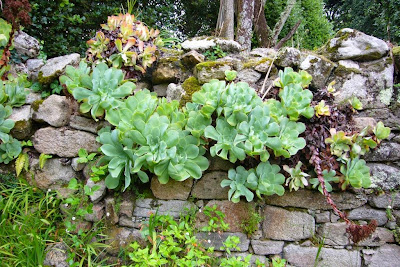 If you can drag your eyes of the view of the valley, you'll notice that the start of the lush foliage is an amazing line of tree ferns. I believe most of these have been hear since the since and are not recently imported. They are some of the finest specimens you will find in the UK.
If you can drag your eyes of the view of the valley, you'll notice that the start of the lush foliage is an amazing line of tree ferns. I believe most of these have been hear since the since and are not recently imported. They are some of the finest specimens you will find in the UK.It doesn't matter how often I see them they always take my breath away, they are simply stunning. The brave can run, or roll depending on your age, down to them and start exploring straight away. The more reserved, can follow one of the winding paths at a more leisurely pace. You are provided with a map that shows all the different paths which you will need to see everything, or you can simply walk down until you come to the beach and then up until you reach the lawn.
There are so many different plants to see, with the garden being split into sections. After the tree ferns, don't worry more photos of them later, if you follow the left hand set of paths you come to the bamboo glen.
There are far to many forms to show them all and the size of the clumps make it impossible to get photos of them. I am going to have to include one of the blue forms in the new garden, being tight clump forming varieties they are perfect for smaller gardens. I dream of having space for one of the really big ones though. The one the right had culms the size of my arm.
Now the stream is a little larger and forms a series of ponds. You never know what wild life you will come across in these.
The banks of the pools are filled with gunnera. It was hard to get a photo that does them justice, especially when the entire group you are with all hate having their photo taken so you don't have someone to stand under a leaf.
Just beyond these were the hydrangeas, which were had just started to flower when we were there. I hadn't realised there were so many forms and colours.
I'm not sure if I had a garden like this and a beach at the bottom, that I would be so generous as to let it be taken over so I couldn't enjoy it myself. But I am glad they do, and at least it seems the manage to sneak some time on their own to enjoy it.
Back up over the wall and up this time the view is up to the house.
There are so many views on the botht he way up and down, if you can stop looking at individual plants that is.
Back up the top of the valley again, and you are back with the tree ferns. There is a large grove of them, with single, double and even a triple trunked specimen. By the look of them, it is so mild that the winter does not finish off the previous years fronds.
The last section is a little stepped section up the side of a sort of water garden. There are some fun neon fish jumping up the waterfalls at the moment.
Finally back up by the lawn it may be the first time you notice that it is covered in succulents and on top of it there is a succulent bank. Again if I had more space this would be something I had in my garden, a sort of succulent jungle. It is something I will be trying to replicate on a slightly smaller scale.
With valley gardens like this it is no wonder Cornwall is such a popular place to retire to, when you get fed up with urban living.


























































